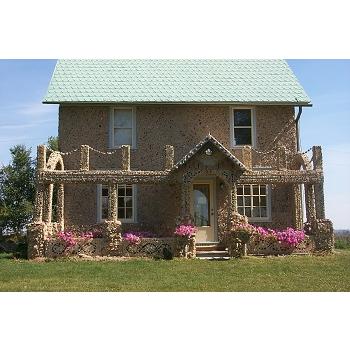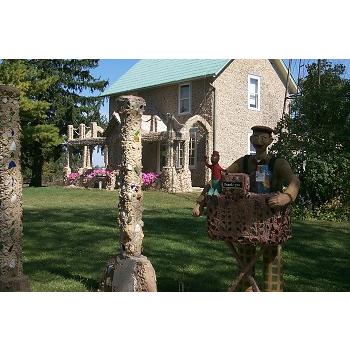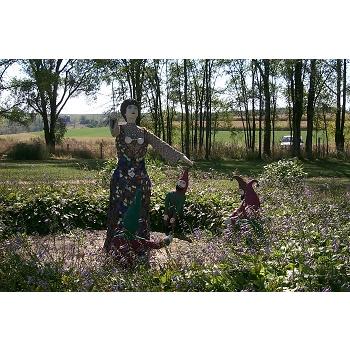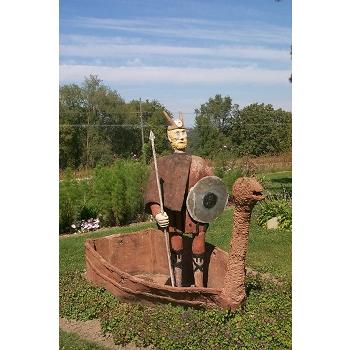Grandview
Born in Austria in 1881, young Engelbert Koletnik attended school in Vienna and later apprenticed with a master machinist. Drafted into the Austrian-Hungarian army, he served two years, then fled first to Europe, then America where he changed his name to Nick Engelbert to start a new life.
In 1913, Engelbert married Katherine Thoni, a recent Swiss immigrant, and in 1922, they settled and raised four children on a small seven- acre farm just outside the village of Hollandale, Wisconsin. Engelbert created his first concrete sculpture in the 1930s, reportedly while recovering from a sprained ankle.
Family members recall that Engelbert was rather quiet about his sculpture production, but, by 1950, his entire yard was transformed into an artistic landscape of over 40 concrete sculptures. Many were arranged in elaborate settings with lush colorful garden beds designed and tended by Katherine. Engelbert also decorated the exterior of the simple clapboard farmhouse with a colorful mosaic of concrete, embellished with stones, shells, glass shards, and fragments of ceramic dinnerware and porcelain figurines.
The surrounding landscape of rolling hills and bucolic farmland enhanced the aura. It was truly for the "grand view" that Engelbert named his sculpted panorama.
In 1951, on his seventieth birthday, Engelbert received a set of oil paints. He soon taught himself to paint, and in the next ten years, created his second body of art, approximately 74 paintings of his Grandview sculpture environment, the exotic places he visited, and the humor and essence of everyday life. These are held by the John Michael Kohler Arts Center.
Katherine died in 1960 and Engelbert soon sold Grandview and moved to Baltimore to live with his daughter. Before he left, however, he painted a final tribute to the pastoral landscape that inspired his life: a mural on the living room wall of the farmhouse that depicted the Hollandale countryside.
Kohler Foundation purchased Grandview in 1991 as part of its ongoing commitment to preserve art and sculpture of self-taught artists. By that time, most of Engelbert's sculpture had severely deteriorated. Many were found in pieces throughout the property and some were missing entirely.
Historic photographs gathered from family and friends were an invaluable preservation tool. They provided documentation and crucial information about individual sculptures and the surrounding landscape.
The historic integrity of Grandview was restored with cooperation and assistance from an extraordinary cadre of professionals and volunteers. Art conservators, curators, area contractors, historians, architects and designers all worked together in a unique collaboration.
Kohler Foundation orchestrated a preservation plan that incorporated conservation, reproduction, and some replication of sculpture, as well as restoration and rehabilitation of the structures. An interpretive exhibit was installed on the first floor of the restored farmhouse that displays photographic documentation, sculpture remnants, and personal archives.
In 1997, Kohler Foundation donated Grandview to the Pecatonica Educational Charitable Foundation, Inc. The spirited stewardship of this group has made it possible to welcome visitors from all over the world. For more information, visit www.nicksgrandview.com.
During the summer and fall of 2016, art conservators from International Artifacts will be on site doing repair and maintenance on Snow White and her dwarfs, and several other pieces.
The Wisconsin Art Environment Consortium created the video podcast below about Nick Engelbert's Grandview:
Nick Engelbert's Grandview







